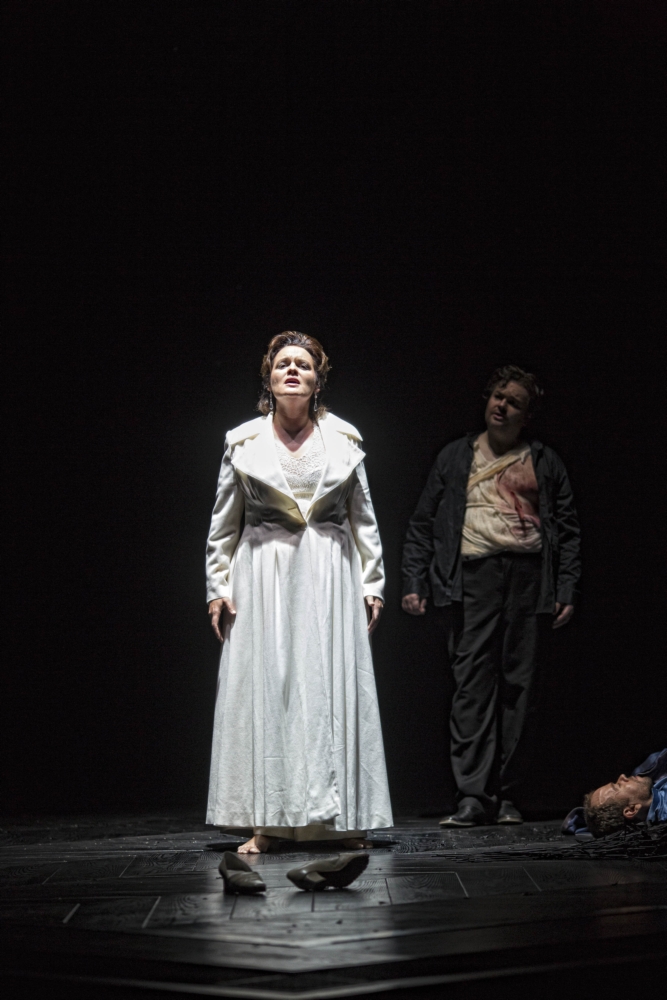A Brünhilde who does not burst into flames but endures the Götterdämmerung with a baby in her arms, a Senta who does not jump off a cliff but is shot by Erik together with the Holländer. No one really looks surprised anymore. And Isoldes who do not die in the Liebestod are no exception, but Tristan who rises from the dead, as it were, by Isolde's notes reaching into heaven, stands diagonally behind her and sings along soundlessly?
Het gebeurt in de bij tijd en wijle letterlijk adembenemende enscenering van regisseur Jacobs Peters-Messers en decor- en lichtontwerper Guido Petzold. Ja, Wagners Tristan und Isolde raakt je keer op keer, telkens op een ander moment, maar vrijwel nooit in de beruchte slotscène. Niet in de laatste plaats omdat de sopraan die de loodzware partij van Isolde moet zingen na al het vocale geweld van de voorgaande drie uren dan al gesloopt is.
Maar na al het bloedvergieten in slotscène – voor het schrikeffect heeft koning Märke een pistool – staat de Zwitserse Claudia Iten daar opeens, in helder wit licht, engelachtig bijna, en zet sereen ‘Mild und leise’ in. In de zes minuten die volgen gebeurt het onmogelijke: zij verklankt in de slotaria schijnbaar moeiteloos alle emoties van de hele opera nogmaals maar dan nog aangrijpender. Het Noord Nederlands Orkest trekt alle registers open, maar het deert Iten niet, zij overstijgt het orkest, de muziek en het drama. Dit is geen gewone Liebestod, dit is geen gewone Tristen und Isolde, hier gebeurt iets bijzonders.
Dat het bijzonder is dat het überhaupt tot deze grote productie gekomen is, mag genoegzaam bekend zijn, maar artistiek en zakelijk leider Nicolas Mansfield geeft er in het programmaboek een draai aan die ironisch genoeg ook Halbe Zijlstra als muziek in de oren zal klinken: “In zekere zin hebben de gewijzigde budgetten ons ook bevrijd van de beklemmende verplichting ons uit te putten in veredelde standbouw en etaleren van een overdaad aan textiel en een overrompelende mise-en-scène.”
Een overdaad aan textiel krijgen we zeker niet te zien. De kostuums van Sven Bindsel zijn sober maar effectief en het mannenkoor, dat alleen in de eerste akte een rol heeft, krijgen we zelfs helemaal niet te zien: “Iedere man die geen kostuum heeft, levert geld op.” Maar achter alle besparingen, schuilt wel degelijk een artistieke visie. “De muziek van Tristan und Isolde is zo diep, ik wilde niet een enscenering die daar erg veel lagen aan toevoegt,” aldus Mansfield in dagblad Trouw. “Daarom heb ik Guido Petzold de kans geboden het licht- en decorontwerp te maken.”
Diens abstracte eenheidsdecor bestaat uit twee vierkante vlakken die zich openen en sluiten, om zo even gemakkelijk het schip als de kasteeltuin weer te geven. De associaties liggen eveneens voor de hand: een diamant, een schaakbord, een oester. Petzold doet ook geen enkele moeite de theatertechniek te verhullen, integendeel: de zijlichten zijn pontificaal in beeld. Je ziet hoe elk lichteffect ontstaat en in de derde akte wordt zelfs de constructie van de vierkanten zichtbaar wanneer ze bovenop elkaar liggen om zo Tristans burcht te vormen.
Een aanzienlijk deel van de handeling speelt zich af voor de opera begint en wordt pas gaandeweg de opera in monologen en dialogen ontvouwd. Het theateradagium ‘show don’t tell’ was aan Wagner niet besteed, maar zoals wel vaker bij Wagner is dit schijn: de werkelijke handeling, het werkelijke drama speelt zich in de personages af en juist dat komt goed tot zijn recht in deze minimale decors.
Mede dankzij de nadruk op de belichting doet het geheel onwillekeurig denken aan de tot op het bot uitgeklede ensceneringen waarmee Wieland Wagner na de Tweede Wereldoorlog Bayreuth weer op de kaart zette. Hij wilde breken met het beladen verleden door zich te focussen op de beweegreden van de karakters. Precies dat doet ook Jacobs Peters-Messers in zijn gedetailleerde personenregie, waarin het kleinste handgebaar betekenis krijgt en waarin niets afleidt van de muziek.
Daar, in de orkestbak, wordt het verhaal pas echt verteld. Vanaf de eerste maten weet Antony Hermus een prachtige klank aan het Noord Nederland Orkest te ontrekken, met fraaie lange lijnen, heldere accenten en een bewonderenswaardige dynamiek. De stuk voor stuk uitstekende solisten varen daar wel bij; nergens hoeven zij zich te overschreeuwen, nergens zien zij zich geconfronteerd met een ongebruikelijke tempokeuze. Dat de Oostenrijkse tenor in het liefdesduet de mindere was van Claudia Iten is geen schande. Tegen haar Isolde was bij de première niemand bestand.
Nationale Reisopera: Richard Wagner – Tristan und Isolde. Met: Noord Nederlands Orkest en Nationaal Opera en Concert Koor o.l.v. Antony Hermus. Wilminktheater Enschede, 22 september. Daar nog 3 voorstellingen, daarna op tournee t/m 31 oktober.

